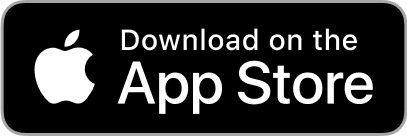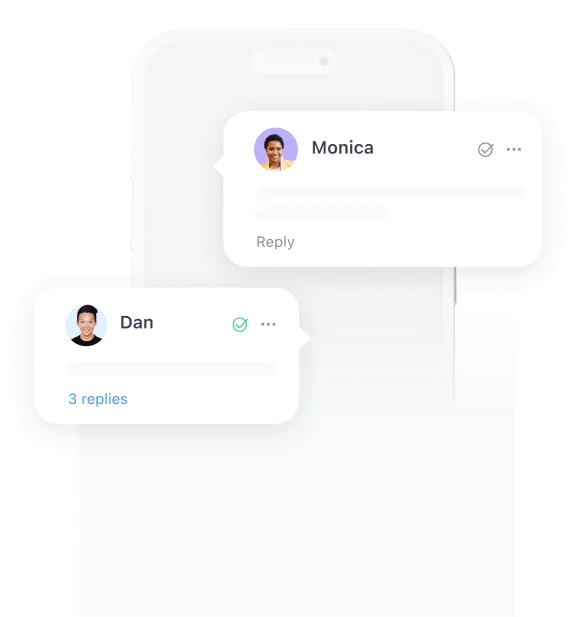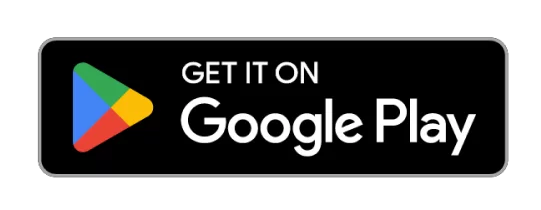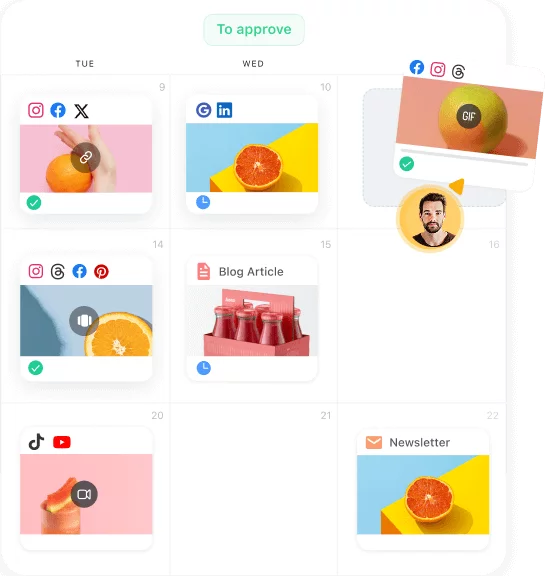For years, marketers fed the Content Monster with nonstop posts. Big names said volume won, so we treated visibility like a numbers game. That playbook’s outdated. Engagement now hinges on quality and clear relevance. According to the GWI study for the Financial...
The social media kit breakdown
Social media kit: guide to a heart-winning brand (+ free examples)

A social media kit is your brand’s press-ready first impression – one that 68% of micro-influencers report helps them get faster deal cycles, according to Influencer Marketing Hub. Think of it as your social media presentation that people can grab, share, and act on.
Why do you need one? Because when someone’s finally paying attention, like a journalist, a partner, a brand, you shouldn’t be digging for your headshot or rewriting your bio. You should be hitting ‘Send’.
So, in this guide, I’ll walk you through a ready-in-minutes roadmap to building a standout media kit that wins collaborations and keeps your brand on point.
What is a social media kit?
A social media kit is a ready-to-share collection of branded materials, such as bios, logos, visuals, audience data, and proof of performance. Its main purpose is to cultivate a consistent presence on social media platforms and help potential collaborators talk about your brand accurately and confidently.
Why every brand needs a social media kit
A strong social media kit gives potential partners the tools to understand, use, and represent your brand. Most importantly, it sets the tone for how you want to be cited, represented, placed, or contextualized.
A media kit is a container for brand clarity, which allows people to engage with your brand and create social media posts in a way that’s aligned with how you want to be seen.
It also saves time, which is ideal because opportunities move fast.
Think of a journalist who needs a quote, a partner who wants to feature you, or a podcast that invites you to speak. You don’t want to scramble at that moment for key elements of your brand’s personality. If someone is already paying attention, having a social media kit allows you to respond with professionalism and consistency.
What does a social media kit for brands include?
A social media kit is a whole interface for how others should approach your brand. It includes visual guidelines, tone of voice, contact points, and even examples of what not to do.
To me, a social media kit is a form of operational brand control. And it’s something even small brands can and should replicate in a way that fits their size and resources. So, here’s what you should include in your standard brand kit:
- Brand overview & brand personality
You need to show who you are, what you stand for, and the brand’s tone. Include a short bio, mission, niche, and one-liner.
- Voice and tone guidelines
Help others write about you accurately. Ask yourself: “What emotions should our content carry consistently?” and clarify those.
- Logo files & visual rules
Include horizontal and vertical versions, high-quality images and transparent PNGs of your logo, key elements like icons, black and white options, and clear guidelines for usage.
- Color palette & fonts
Lock in your visual identity. In a recent talk with the Creative Designer at Planable, Eduard Hodorog, he explained:
Make it hit every key aspect like fonts, colors, imagery, and specific design decisions.
- Image & video style
Add sample visuals or reference moodboards. Consistent photography and editing direction go a long way in building recognition, especially on social platforms.
- Top performing posts & metrics
Highlight past content that resonated: engagement stats, reach, or reactions from social posts. Use tools like Planable Analytics to pull reliable, clean visuals here.
- Press mentions & testimonials
Showcase social proof like co-branded content, client feedback, interview links, or pinned partner tags to build trust with potential partners.
- Contact details & CTA
Make it easy for someone to follow up, feature you, or request your full pitch deck. Make your contact info accessible, and the next step clear.
- Optional: AI prompts for safe use
Add custom GPT-style prompts for your team or collaborators, like “What tone should I use when posting about [brand] on social media platforms?”.
5 steps to create a winning social media marketing kit
Repeat after me: a standout social media kit does not start in Canva. Instead, it starts with clarity around who you are, how you show up, and what you want others to reuse without needing your approval. So let’s lay out the blueprint on how to bottle up your brand’s personality into a neat social media kit, according to branding experts.
The advice of our Creative Lead, Alexandra Prodea, is to start simple:
Even if you can’t build the full kit yet, start with the basics and give your brand a personality. Treat it like a person. How would it talk, act, show up online? That alone will help with consistency. Then, just lock in a few visual elements like logo, colors, fonts. Stick to those across platforms and you’ll already be ahead of the game.
1. Define your brand’s visual identity
To lay a sound foundation for your media kit, start by answering these 6 questions:
- What exactly are we building and why?
- What does our brand stand for?
- How do we want to be remembered?
- What do we want people to feel when they first interact with us?
- What tone of voice do we use in different contexts?
- What emotions should our content consistently evoke?
- Who do we want to attract and how do we want to be positioned in their mind?
The answers you give to these questions will inform your bios, pitch, visuals, and calls to action.
Alexandra Prodea, Creative Lead at Planable, has this hot tip for defining your visual identity:
Start by getting crystal clear on who you’re speaking to and why you exist. You can’t build a meaningful brand if you don’t know its role in the world. Talk to stakeholders, research the market, understand where the brand fits and how it should stand out. The identity needs to reflect everything the brand is, not just look nice.
2. Nail your visual guidelines
Think of this part as your brand’s design survival kit, which should include design elements and guidelines like:
- Color palette (HEX and RGB)
- Logo variations and files (horizontal, stacked, transparent, dark, light, mono)
- Image treatment (filters, composition, lighting style, for brand consistency)
- Typography rules (with alternatives for Canva or Google Fonts)
- DOs and DON’Ts across all social media platforms and web, print, or other types of content
Creative designer Eduard Hodorog said, and I quote
I love approaching projects like these with the KISS method (Keep It Simple, Stupid!). Start from the inside, understand who you are and who your audience is, and don’t chase those flashy trends.
3. Highlight your social media performance
Numbers don’t tell the full story, but they open doors. Add clean visuals of your follower growth, average engagement rate per platform, and actual post-level performance. Prioritize the stats that best match your goals (collaborations, huge follower count growth, reach to your ideal audience demographics, retention, how often they engage, etc.), instead of just the biggest ones.
Use Planable Analytics to pull a cross-platform snapshot of your strongest metrics in one go. It’s built for creators and teams who want to skip spreadsheets and get straight to the point, generate insightful social media reports, find key metrics, and share all the information with one click.
If you’re pitching to partners, aim to show how your target audience behaves (clicks, saves, replies). A smartly structured social media report gives you the credibility of a strategist, rather than a simple creator.
4. Curate compelling examples and top-performing posts
Your social media kit needs to include real campaign results, screenshots of top-performing social media posts, before/after metrics, and examples of how others have used your assets in public.
Highlight the impact of your hashtag strategy, curate 2–3 post examples that convey emotion and represent your personal wins, and explain why. Add moments where your content resonated deeply, sparked conversation, or led to meaningful engagement or opportunities instead of just posts.
If you’re early-stage or rebranding, why not use speculative work? My advice is to create mockups, run demo campaigns, or post breakdowns like “If I were hired by X brand” to signal initiative and build trust with other brands, sponsors, or anyone interested in a partnership.
Or, you can also reach out to small brands and offer value in exchange for a testimonial or repost. That proof builds faster than waiting to be picked by potential collaborators.
Tip: If you’re documenting comments, DMs, or testimonials, Planable’s engagement features make it easy to monitor, group by sentiment, and screenshot interactions across platforms in one click.
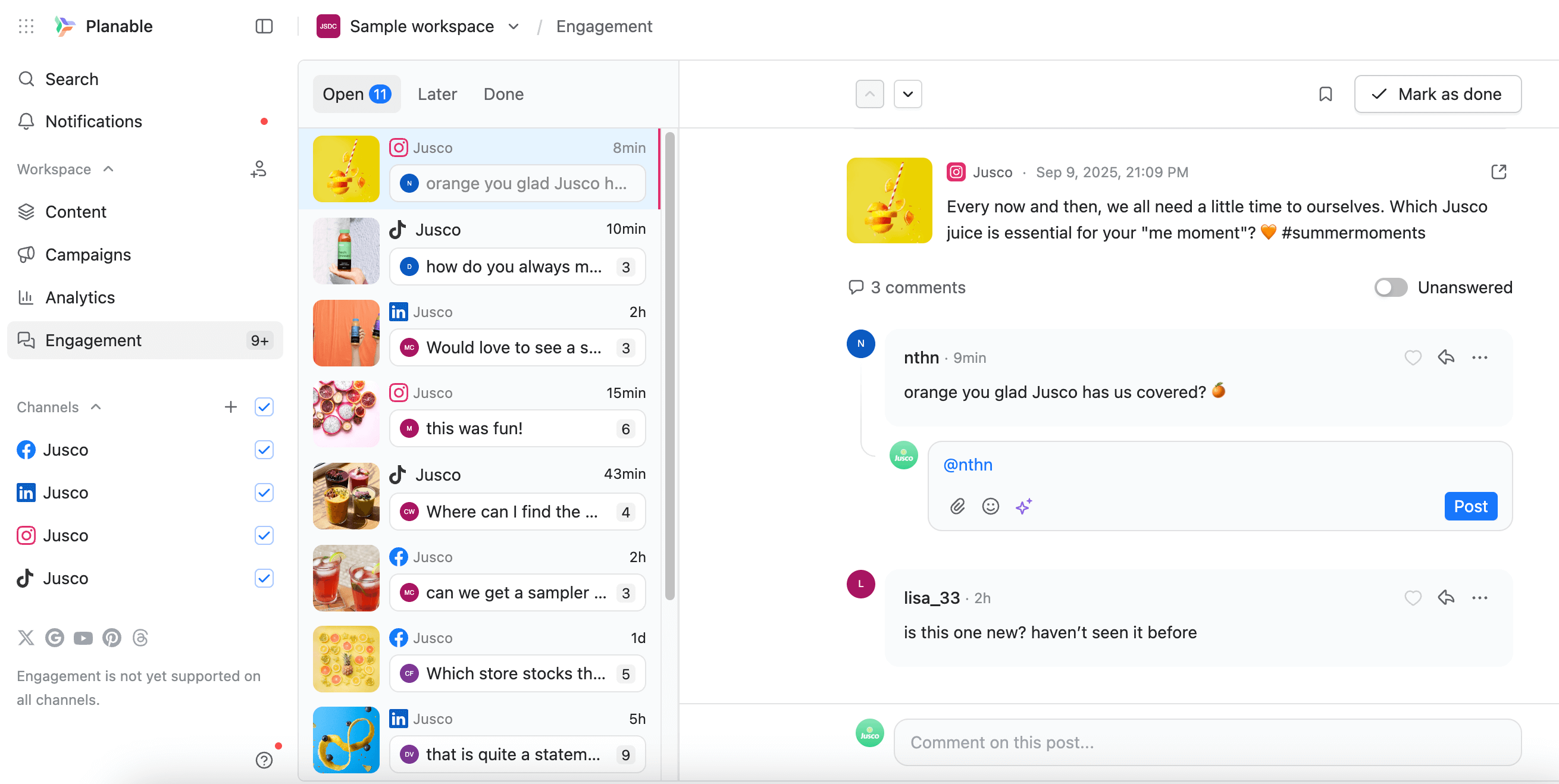
This engagement dashboard in Planable helps teams reply to comments across platforms directly in one workspace.
5. Package it all in an on-brand, shareable format
Don’t fall into the trap of thinking that if you can make sense of your stuffy document, everyone can. Turn your social media kit into a clean, mobile-friendly format that’s easy to share via PDF or an interactive link.
In fact, why don’t you use Planable’s guest view links to showcase sample posts or even your whole grid? No login needed.
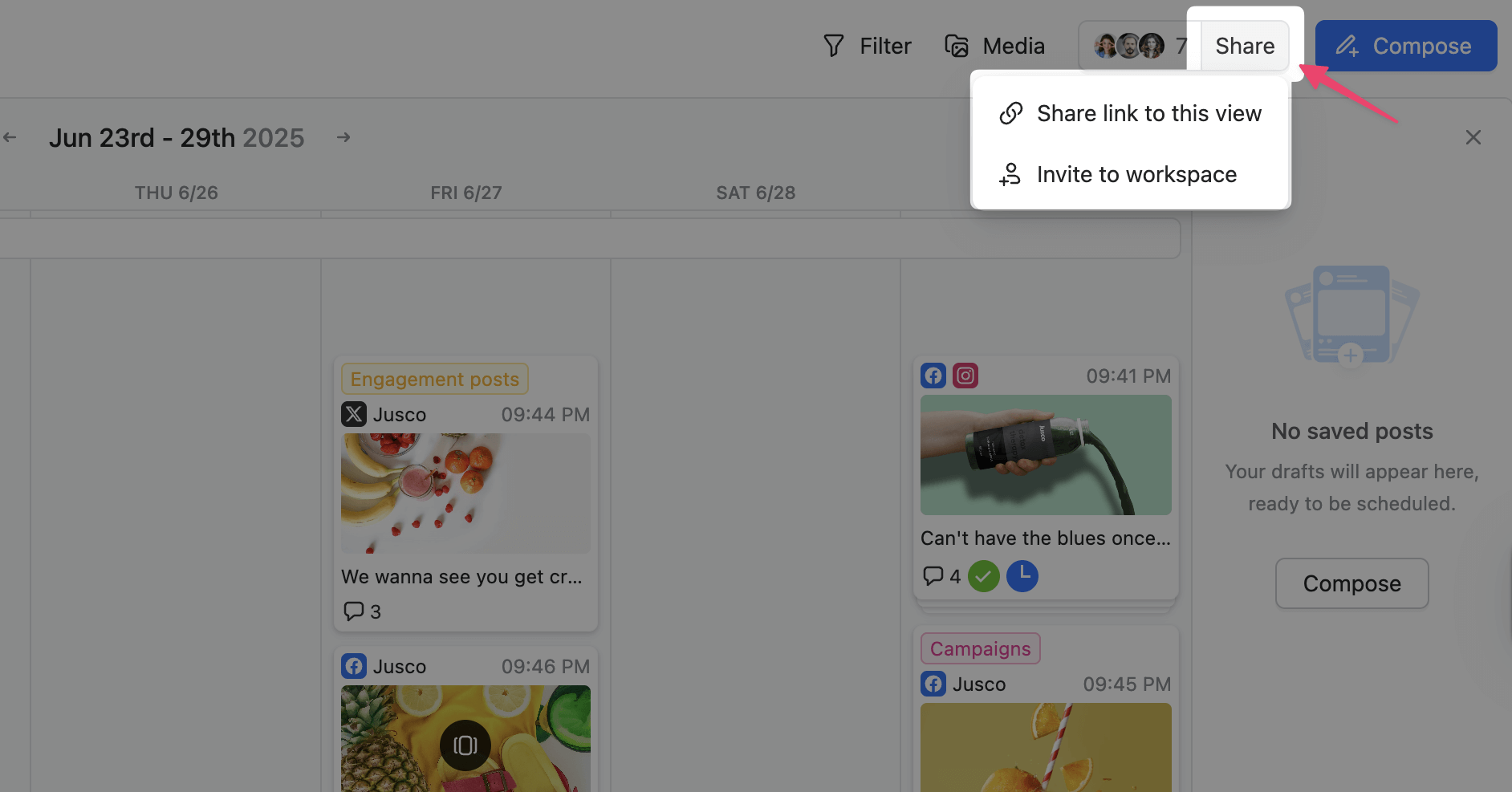
Shareable guest link in Planable lets users preview scheduled content without needing an account.
This makes it easy to send your kit to press, collaborators, or agencies with just one link, then get feedback or approval fast. It’s slick and easy. Plus, it makes you look like you’ve got your brand or influencer media kit together.
3 social media kit examples to spark inspiration
Let’s explore three of my favorite brand kits on the internet right now.
1. Slack: accessibility meets simplicity

Slack brand assets page with downloadable logos, product images, and access to their brand center.
Slack‘s media kit website page is all about accessibility and structure. Everything’s split into clearly labeled sections:
- Logos
- Product screenshots
- Slack brand center
You get multiple file formats, and download buttons are intuitive and instant. The landing page is minimalist and without friction.
2. Ahrefs: consistent branding made effortless
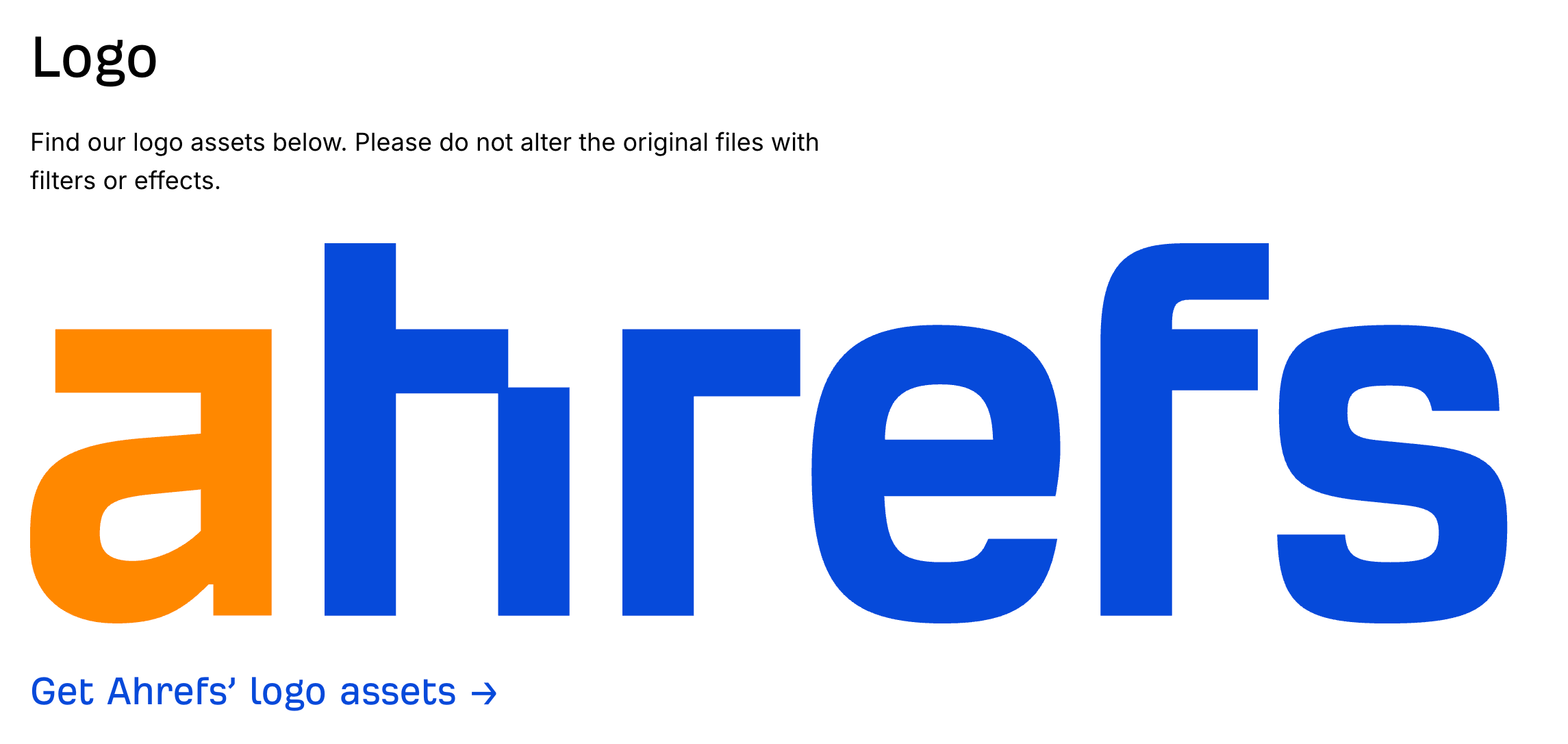
Ahrefs logo available in PNG and SVG format, shown as part of their downloadable media kit.
Ahrefs offers a landing page for its media kit, where you’ll find their brand values, use of assets, color scheme, quotes, and everything else you need to maintain consistency when referencing their brand. Every section is direct and offers a CTA, like a download button or a point of business contact.
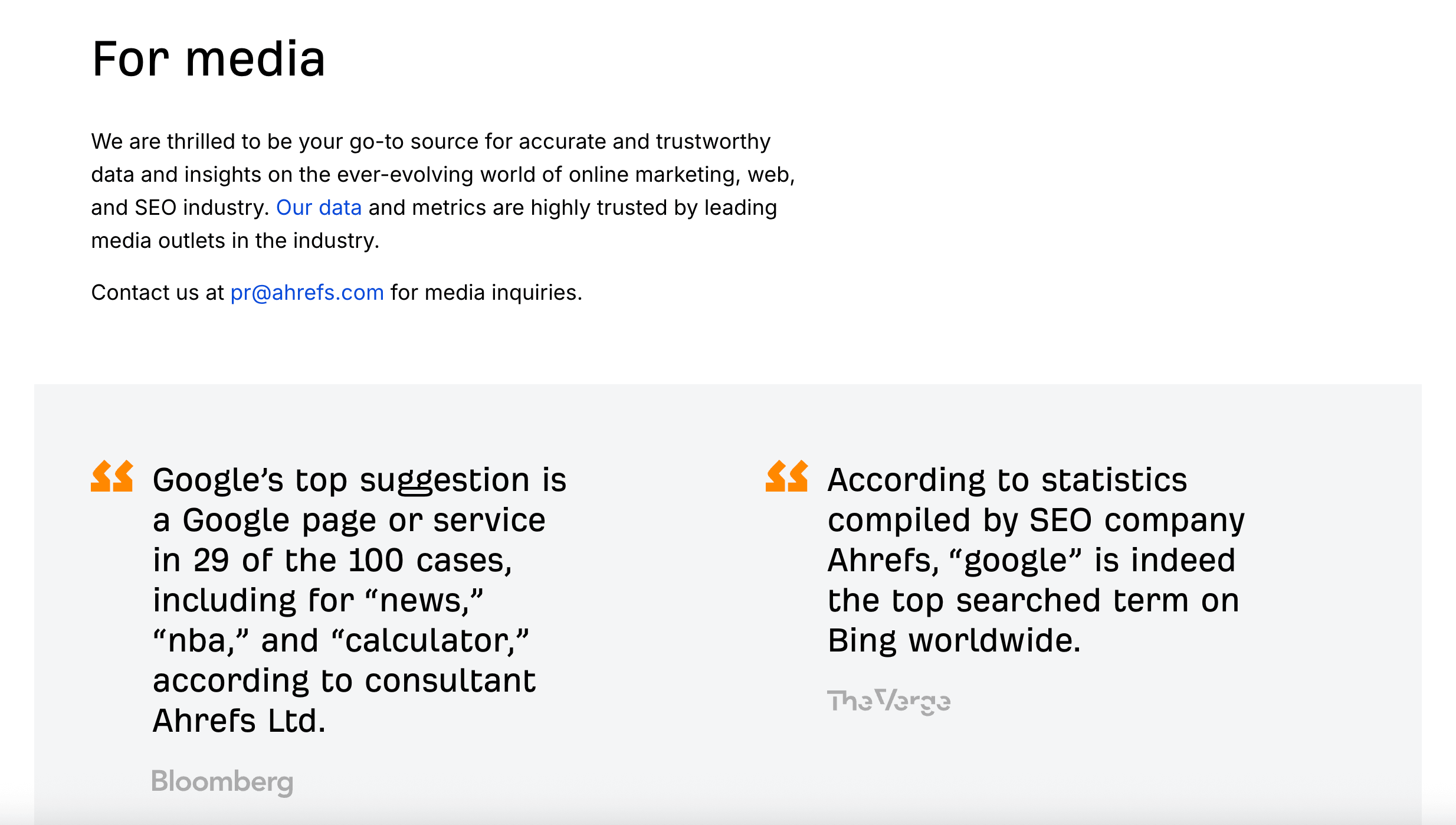
Ahrefs press page with contact info and SEO-related media quotes for journalists and publications.
3. Blinkist: polished, editorial, and voice-driven
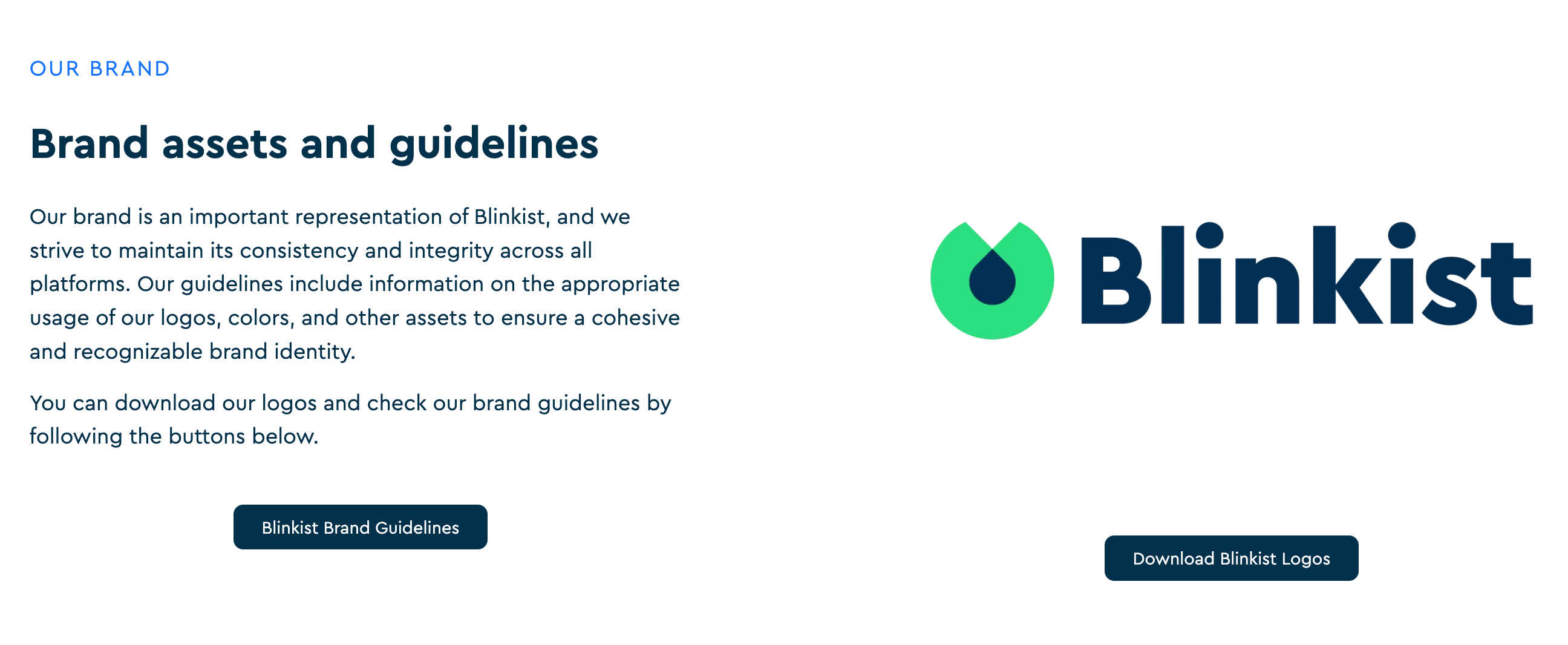
Blinkist’s media kit reflects its editorial voice, offering structured access to brand visuals and messaging.
Blinkist’s media kit has a polished, editorial feel. Visual hierarchy is strong, and brand voice is embedded right into the page. It’s perfect for design-conscious users or collaborators who want clarity on everything, from the use of photos and styling of images to brand logo guidelines, creating branded social media content, and more, without having to dig.
How to make a social media kit using Planable
Here’s how to build a living, collaborative media kit with the help of Planable. Follow the exact steps brand managers, PR leads, and content teams use to make approvals simple and maintain control.
1. Start with a universal content post
Create a new universal post in Planable. This format is purpose-built for static assets like kits, guides, or pitch decks. Include these sections:
- Brand elevator pitch (around 3 lines)
- Extended “About Us” paragraph
- Social handles (link to live profiles only)
- Press contact or media inbox
- Visual identity intro (1-line summary of your style)
This sets the tone. It’s the intro paragraph to your brand’s résumé.
2. Upload visuals and proof points
Drag in your logo suite (SVGs + PNGs), brand photography, product screenshots, and social proof. This could be:
- Best-performing IG, X, Pinterest, Facebook posts
- Featured press logos (with links for easy access)
- Real performance stats (e.g., “Top 10 on Product Hunt by Industry, June 2024”)
Use Planable’s cross-platform preview to double-check how each asset renders across devices and formats.
3. Collaborate with the team, in sync
Use comments to request edits from legal, brand, or leadership. Instead of passing around PDFs, Planable’s multi-level approval flow lets everyone review in one place.
My tip is to set clear reviewer roles. For example:
- Design – asset accuracy
- Brand lead – tone of voice
- Marketers – Usage guidelines, DOs and DON’Ts
- Comms – final approval
This helps prevent the “latest version?” email chain.

Multi-level approval workflow in Planable showing roles, permissions, and content access for each user.
4. Generate bite-sized versions with Planable AI
Once your bios and data are finalized, use Planable AI to create:
- Speaker intros for panels
- One-liners for IG captions
- Snappy pull quotes for email footers
5. Monitor what gets used and how
Use Planable Analytics to spot your best-performing posts across platforms, then build your media kit around them.
- Identify content with the highest audience engagement, reach, or reactions.
- Save top posts to a universal workspace labeled by use case (about, launch, press).
- Add usage notes: when to post, what format works best for your target audience, what to tweak.
- Refresh regularly based on new performance data to keep your media kit up to date.
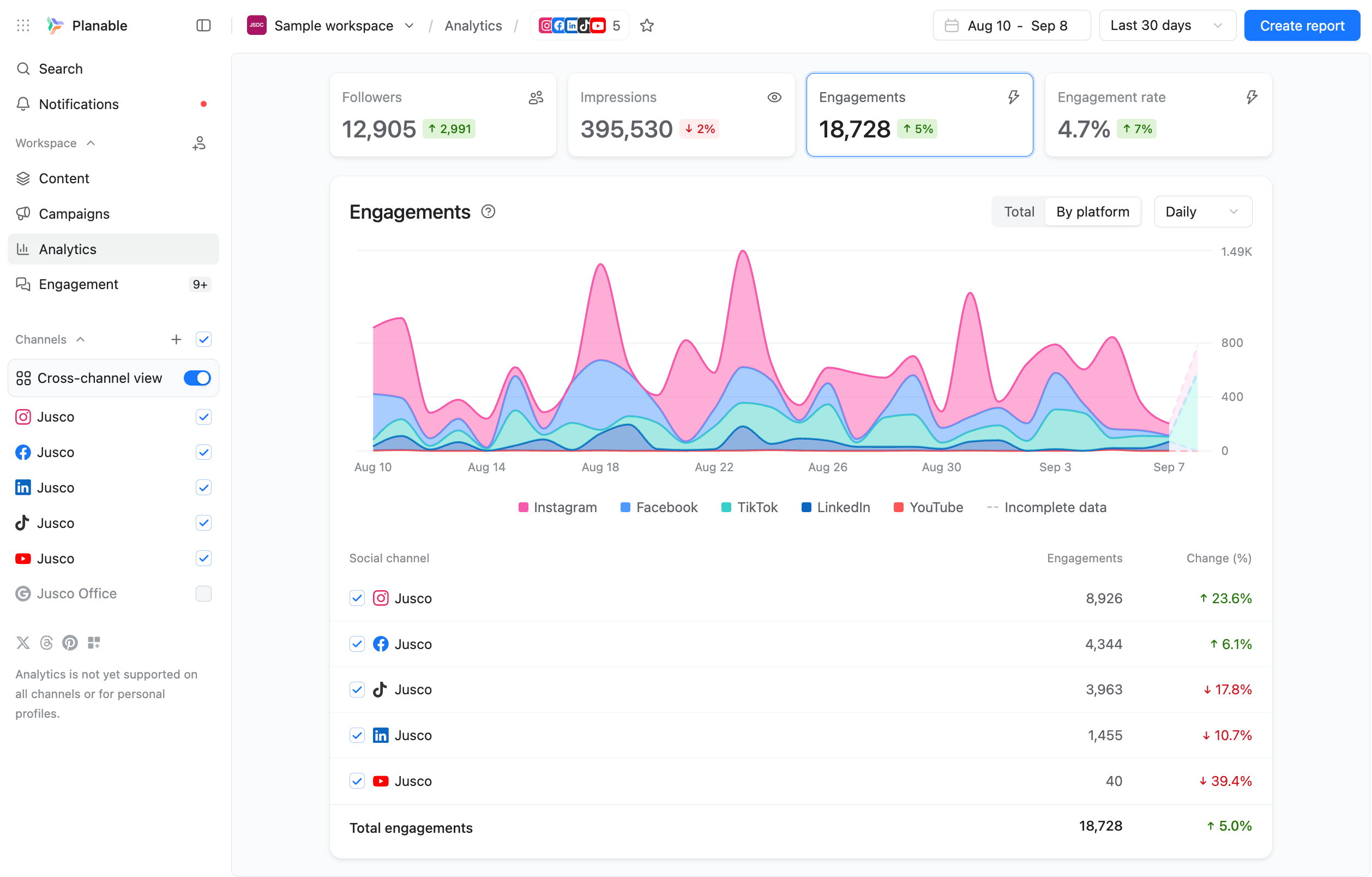
Planable’s cross-channel analytics visualize engagement performance across major social platforms in one view.
FAQs about making an evergreen social media kit
Here are questions you might need an answer to ASAP, no matter if you’re building a large brand or influencer media kit.
How long should a media kit be?
There’s no fixed length. It depends on your brand’s scale and how you plan to share it. For most creators or small brands, a concise 3–5 page PDF is ideal: long enough to cover the essentials without overwhelming the reader. Focus on the core elements: your brand story, audience insights, key metrics, and a few strong content samples.
For larger brands or agencies, a modular, web-based format can work better: separate, skimmable sections (one for brand story, one for audience data, one for samples). The goal isn’t to cram everything into one file, but to make your media kit quick to navigate and easy to update. Anything beyond the essentials starts feeling more like a full pitch deck than a true media kit.
Who needs a media kit?
If you’re serious about brand partnerships, press visibility, or influencer deals, you do. Social media kits aren’t just for creators. A small business brand, a startup company, an NGO, an influencer, and even agencies benefit from having one ready. It saves time, sets the tone, and shows you’re operating with professionalism.
How often should I update my social media kit?
Update it quarterly, or whenever your target audience grows, your offers change, or a campaign significantly shifts your results. Use Planable Analytics to spot your highest-performing content, then feature that in your kit to prove what works. Let your top posts speak for your brand, not old boilerplate.
Time to craft a professional media kit for your online brand
Your media kit is proof of performance, so make sure to build one that reflects what you do best and how you want to be perceived. With Planable, you can analyze real results, gather your strongest content, and publish (the proper way).
Get started for free today – no card required, and your first 50 posts are on us.

Maria is a content marketer, SEO copywriter, and social media specialist with experience working for a wide range of B2B businesses. She loves to keep up with the evolution of digital marketing, particularly in areas such as social media management, content, SEO, and PR. She is passionate about her work and loves to add a unique spin to any topic.
